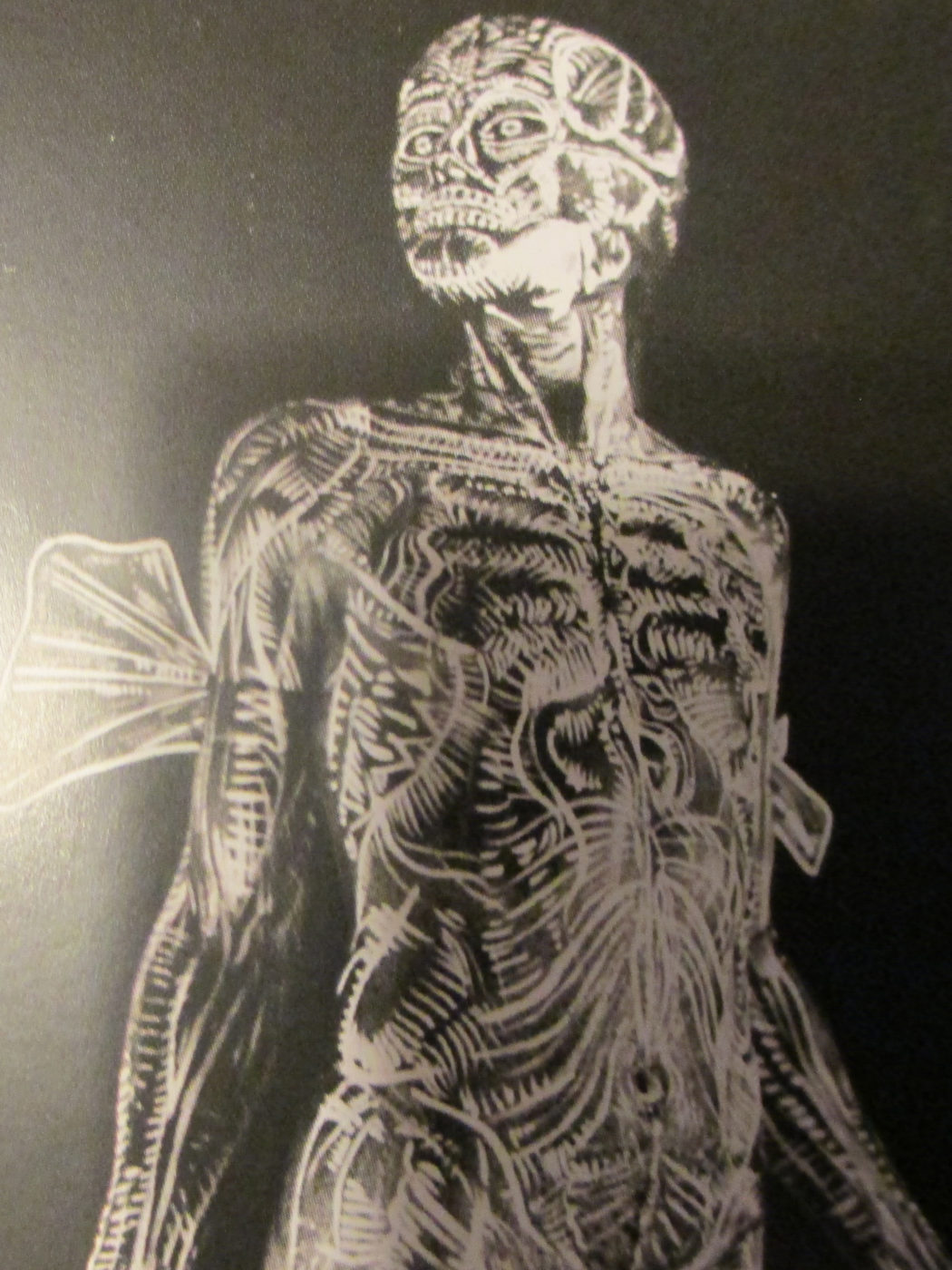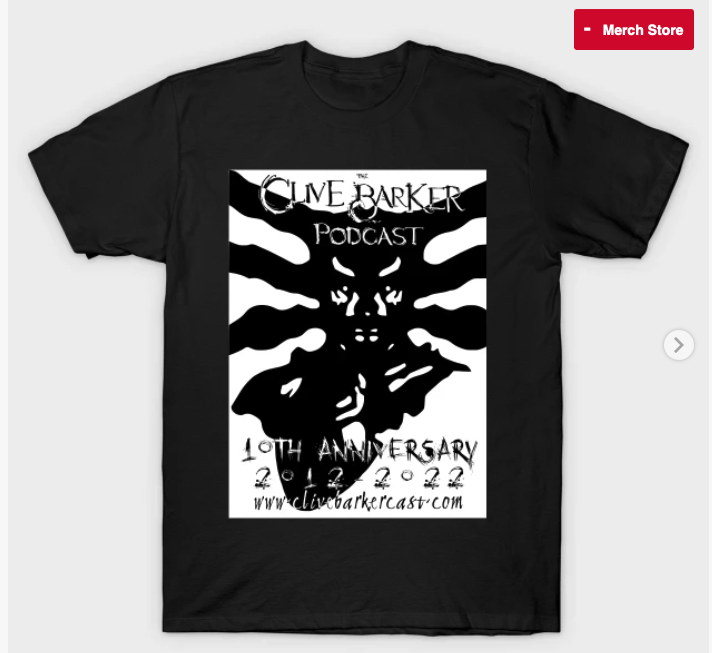Review: Damnation Games
This is review dedicated to Simon Sayce. Keep fightning and never stop!
At the end of last year I reviewed the wonderful bluray collection of the first three Hellraiser films called The Scarlet Box. It was produced by the cult film loving company Arrow Films who put together quite the package for the fans with this set. I also think it won a couple of awards. From the excellent video and audio presentations of each movie along with a ton of extras, you couldn’t ask for anything more. You can read my very positive review of it here.

Clive Barker’s Hellraiser is a film that’s affected me in many ways over the years. Each time I watch it I find myself reflecting about the limits of the imagination. When I first saw the movie it opened a new door for me to expand upon my own creativity. Especially my hidden desires for sex and violence in stories. Like a lot of Barker’s work it also made me want to confront my personal beliefs and how life isn’t so black and white. Behind closed doors people aren’t what they seem.
The first two Hellraiser films and parts of Hell on Earth set a standard for a different type of horror movie that has long since passed. The creators of these films took the monsters seriously and were happy to indulge themselves in the gory and sexually explicit details that many filmmakers would never think of putting on the big screen at the time. To this day I still find it amazing that Hellraiser was even made.
Which brings me to Damnation Games, an exclusive collector’s book to The Scarlet Box that was put together by Clive Barker’s personal archivists Phil and Sarah Stokes who run the official Revelations page and The Clive Barker Archive. They’ve done a wonderful job over the years collecting and organizing Barker’s work in a way that makes doing research on the sites very easy and entertaining. And most of Podcast news comes from them. They make us look good and we thank you very much.
The book is a quick hundred and ninety six pages with various pictures from each film shown throughout. The front hardcover of the book is of Frank’s reassembled face after he’s opened the box. On the back is a bird’s eye view of the top of the box with four chains shooting out of each corner from it. The material that the book is made of is very good as well. The style of paper that’s used is very glossy. Its broken up into eight short chapters with an Acknowledgement and Restoration pages at the end.
For this review I’m going to do a break down of what I enjoyed the most about each chapter.
Chapter One: The Surgeons of the Gods
This was by far the best part of the book for me. I enjoyed reading about how all the ideas that make up Hellraiser were brewing Clive’s head for many years. These obsessions about a story of intense passion and desire and how a puzzle solves the ability to explore the perversity and depth of those human desires was something he couldn’t shake off.
An early idea for Pinhead goes all the way back to the musical play Hunters in the Snow with a character called The Dutchman ironically played by Doug Bradley who would go on to play the horror icon many years later. Even though this was discussed before in the Leviathan documentary I believe it’s important to bring back up. It’s an important part of history where the franchise started.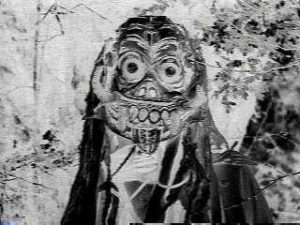
It really all began when Clive wanted to adapt Christopher Marlowe’s play The Tragical History of the Life and Death of Doctor Faustus into a film. So he and Doug began to write a version of the script back in 1974 simply called Faustus. The first version of the script was absent of the puzzle concept, but this was written in the following drafts. The reader is given excerpts from the script and how each version evolved from one another.
When Clive tried to get funding for the film it wasn’t met with much enthusiasm. In a letter from potential backers they ask Clive, “What is sublime and wonderful about being skinned alive?” I think that foreshadows all the problems he’s had with Hollywood over the years when trying to get projects off the ground.
Eventually this project would grow into the short film known as The Forbidden. We get some really cool behind the scenes stories and photos. There’s a deleted image from a sequence from the film that shows Peter Atkins completely bandaged as the prisoner. It reminded me a lot of the Universal monster movie The Mummy. There’s also a complete shot by shot breakdown of the film’s script that I’ve never seen before.

It’s sad that they didn’t get to finish the film the way wanted to at the time because I think they were creating something very unique. If they would’ve finished it though I don’t think we would have the movie we all love known as Hellraiser today. The story wasn’t ready to be told yet. Clive even makes a comment about how Hellraiser was the true completion of all of these ideas over the years.
Chapter Two: Hellraiser Press Kit
A lot of the stories shared here can also be found on the Leviathan documentary. The press kits also contains a story synopsis and bios for the filmmakers and actors.
Chapter Three: Hellraiser: Faustus Endures
This chapter goes even further about the beginnings of Hellraiser and contains some interesting and fun factoids that I didn’t know.
We find out that Clive actually talked to Game of Thrones author George R.R. Martin about Hellraiser when Martin was a guest editor for Night Visions Three.
I also liked the stories about Clive’s close friendship with Michael McDowell and how he encouraged Clive to make Hellraiser. He’s the one who really inspired Clive to make the movie on his own.
When hiring makeup effects wiz Bob Keen, Clive learned that he’d worked on Return of the Jedi and was overjoyed. Apparently Clive loves the character Jabba the Hutt! With Hellraiser he and Bob wanted to create completely new monsters and wanted to make sure the film stayed away from, “yes, but I’ve seen it before monsters.”
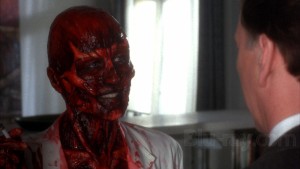
Clive goes on to talk about how he felt out of his element as a director for the first few weeks of filming. Luckily he was surrounded by a group of very talented professionals and they helped him through it. Especially director photography Robin Vidgeon.
Oddly enough he thinks the first twenty minutes are the weakest because of his inexperience. I have to disagree with him here. I think the first twenty minutes contains some of the strongest material in the movie. The scene with Frank opening the box and seeing the cenobites for the first time sets an excellent tone for the rest of the movie.
He talks about his affections for monsters and even references The Bride of Frankenstein. The scenes with the old man and the monster are some of his favorites. I couldn’t agree more with him here.
To end the chapter he confesses about how he really enjoyed making Hellraiser because there was no need to conform to the standards of the Hollywood machine at the time. He was able to make the movie he wanted to without the interference from a studio. I’m sure it was nice that New World loved the movie as well. Not many movies today get that kind of support from studios, especially horror films.
Chapter Four: Hellbound: Hellraiser II Press Kit
Just like with the previous press kit for Hellraiser there’s a story synopsis and bios for the filmmakers and actors, but there are some interesting stories that I didn’t know about. At one point in time it appears Peter Atkins was going to adapt Nightbreed for the big screen while Clive was prepping his next movie which was to be Harry D’Amour: The First Adventure! I guess since that didn’t pan out he decided to do Nightbreed instead and let Atkins write Hellraiser III.
Also worth noting is that actress Ashley Laurence talks about an adaptation of Stephen King’s Apt Pupil that she was cast in, but after only one day of filming the production closed down.
Chapter Five: Hellbound: Another Underworld
When Clive wrote the novella of The Hellbound Heart he never imagined the story going any further than that. During the writing of the script for Hellraiser though he began to see another world that could be explored through the Lament Configuration.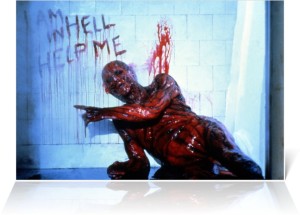
There’s also a funny story about a screening of Hellraiser that was literally going to hell. The projector broke down twice and attendees started cussing and throwing beer cans at the screen. Thankfully after fifteen minutes of watching the movie and realizing this was going to be something totally different they all shut up. Clive sat in the back of the theater smugly smiling to himself.
I was also glad to learn that Halloween and Halloween II (the originals!) were used a reference point of how Hellraiser and Hellbound were connected. When I think of movies that can be watched back to back I always think of these films. I wish sequels would go back to the classic serial style ending where the audience is left hanging. It was a fun way for the audience to leave the theater that kept them talking about the movie.
Peter Atkins original version of Julia and Channard’s relationship was a little to campy for Clive tastes. He suggested that Peter make it more tough by having the two characters share similar ideals about Leviathan and the world of the Labyrinth.
I’m sure a lot of you know that in Peter Atkins original script for Hellbound that Leviathan was a sort of H.P. Lovecraft style creature that hung in space. It was known as “The Great Wound” and it was the original creator of the cenobites. The book gives us script excerpts from Atkins second draft and details a different birth of the Channard Cenobite which started out as bloody fetus and slowly grew into a new cenobite.
The set for Frank’s personal hell was also very different. The original set was supposed to be much more intimate in look and feel. In the script it was a bare white chamber with gauze walls and ghost girls. When Atkins first saw the set he thought they were shooting a different movie.
Something I didn’t know and I wish would’ve worked out was that Clive originally had a cameo in the torture pillar at the end of Hellbound. Sadly it was cut because the filmmakers felt it didn’t look right with the rest of it. There is a picture that’s shown and I thought it looked pretty good.
To end the chapter I was surprised to learn that Clive wasn’t impressed with the rough cut of the film when he first saw it. I don’t think he hated it, but thought it should’ve been more intense. So he wanted more insert shots to enhance the horror of the movie. Whatever they were I’m sure they helped.
Chapter 6: Hellraiser III Press Kit
Just like the previous press kits this gives us the same thing: A story synopsis and bios, and production notes. There was nothing really new here that a lot of fans haven’t heard before.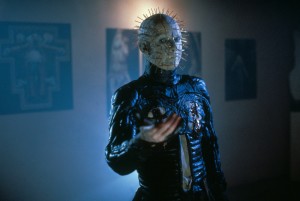
Chapter 7: Hell On Earth: Pinhead Unbound
This for me is where the series began to slowly go downhill. When the Hollywood machine got involved with the franchise they wanted a new monster like Freddy and Jason. I even read a review of Hell on Earth by critic Leonard Maltin in which he said, “these are starting to make Freddy look good by comparison.” Ouch!
Luckily we still had actor Doug Bradley returning as Pinhead, writer Peter Atkins providing the script, and Image Animation would once again return to create the effects. I enjoy the final version of Hell on Earth, but it’s obvious that it was made for more commercial reasons rather than making a sequel similar to the previous films. It started to play it safe which is something I know Clive Barker can’t stand when creating something that’s supposed to scare the audience.
What’s more frustrating about Hell on Earth is that it’s really a missed a opportunity because there were so many other interesting stories that Clive and Peter had in mind that I think would’ve made for a better sequel. There’s an interesting article that Peter Atkins wrote up about all the aborted ideas for Hellraiser III on the official Revelations page. Here’s a to the link the article if anyone is interested.
http://www.clivebarker.info/hellraiser3atkins.html
Just like with Hellbound Peter was already working on the script for Hell on Earth even before the second film found its way into theaters. I loved how much New World believed in this franchise. It’s sad that the company went under because I truly believe if they would’ve continued to make the movies they would’ve turned out so much better.
We also get some more details as to why Tony Randal was kicked off the movie. He wanted to make a more sci-fi/darker film in the same bizarre visual style of Hellbound, but the producers wanted a more commercial feel to the movie and therefore Tony was let go. God forbid he actually wanted to make a good film.
Enter director Tony Hickox director of Waxwork and Waxwork II: Lost In Time. Hickcox is a director that knows how to shoot a movie with a lot of visual style and flair, but I don’t think he was right for the Hellraiser franchise. Some will debate that, but that’s my opinion on the matter. Clive felt the same way too when Hickcox was announced to direct the picture after Randal was let go. He knew Hickox could deliver on the visuals, but wasn’t sure how well Tony could tell a good story that made sense. He gave him few suggestions before he went to Greensboro, NC to shoot the movie.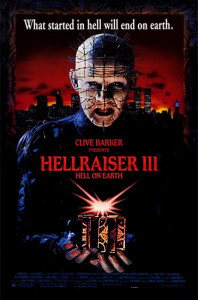
1. Not to make it funny.
2. And to tell a good story.
After that he never heard from them again for nine weeks until he saw the rough cut of the movie.
The producers originally wanted a more comedic slasher style movie that was more like the Nightmare On Elm Street sequels that were being released at the time. Thankfully, Peter Atkins begged them not to go down this road and they surprisingly listened to him. I still feel in someways there are moments in the movie where the final product does fall into this territory. Especially the scenes with Pinhead’s new cenobites. I guess there’s only so many battles a writer can fight and win.
An another aspect that I wish Hell on Earth would’ve delved deeper into was Elliot Spencer’s backstory. Originally both Atkins and Bradley wanted to show more of this material, especially Doug. In the finished film this is sadly just brushed over so they could get to Pinhead killing more people. I think it would’ve given the audience something more to chew on like the earlier films did.
In one of Peter Atkins earlier drafts of the script there was a wonderful scene where Pinhead confronts two cops in an alleyway. The scene was actually story-boarded to be shot and Bradley was very excited about shooting it. But when he got to North Carolina to begin shooting there was a new draft of the script waiting for him. This new version had the scene taken out. There are excerpts of the scene and pictures of some of the storyboards. Bradley feels that when the scene was removed that it weakened what Peter was trying to do with the character. After having been separated from Elliot Spencer this new Loki version of Pinhead could be as nasty as he wanted to.
Doug does admit the toughest part of the shoot was seeing someone else play the character and in the makeup. It obvious that he’s become very protective of the character over the years and doesn’t like to see other people in the makeup. But I’m sure with Revelations and the upcoming Judgment he probably has different feelings on the matter now.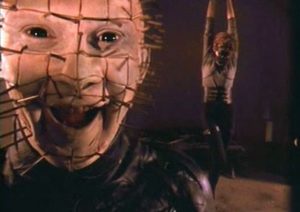
After shooting had wrapped and rough cut was made a producer showed the film to Clive to get his input. Clive thought the movie looked very polished and well made, but it contained all the fears he had about the director’s previous work taking over the story. He also thought the movie’s ending didn’t work because it wasn’t even finished, some sequences didn’t even make sense, and the digital effects were less than stellar. The producer wanted to pay him a good amount of money if he’d put his name on the film to promote it, but Clive declined citing that the film didn’t represent Hellraiser the way he saw it.
Dimension Films then bought the US film rights and wanted Clive’s involvement. He came in and beefed the movie up for them. He did work on the special effects scene where the girl gets skinned, and directed some insert shots at the end when Joey is dangling from the ceiling by the chains.
The book also offers a written outline for the Motorhead video written by Clive. I always think of Clive’s first novel The Damnation Game when I watch Lemmy and Pinhead playing cards. It’s a fun video and it was only appropriate that Clive introduced Pinhead to the mainstream in such a entertaining fashion.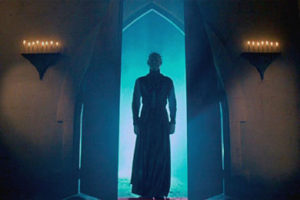
Chapter 8: Pinhead: A Study In Scarlet
The last chapter mainly talks about how Pinhead has become such a horror icon across the globe. Everyone gives their opinions as to why the character has had such a lasting longevity, but it’s Clive Barker who feels the character has over stayed his welcome when Pinhead showed up on Jay Leno to promote Hellraiser: Bloodline. In the segment Mel Gibson looses a button on his coat and Pinhead comes in to help fix the problem. At the time I thought it was a cool way to get the movie out there to a wider audience, but looking back it only made the character laughable. He’d become of shadow of his former self.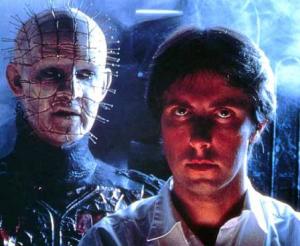
This isn’t the final word that Phil and Sarah Stokes have on the Hellraiser franchise. There’s a more in depth book on the original film coming out sometime in the near future. I’m sure I’ll be getting that as well.
Even though he killed off the character of Pinhead in the literally world with The Scarlet Gospels, I think Clive will always have time for the character. He’ll be talking about this “son of a bitch movie” for many more years to come.
I’d also to thank Peter Atkins for patiently waiting for this review. I hope it was worth it.

